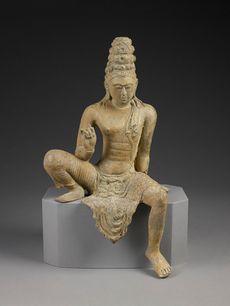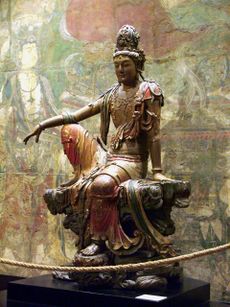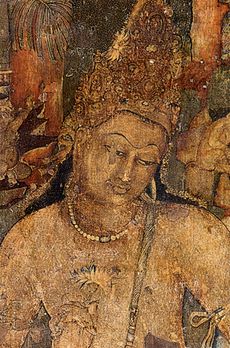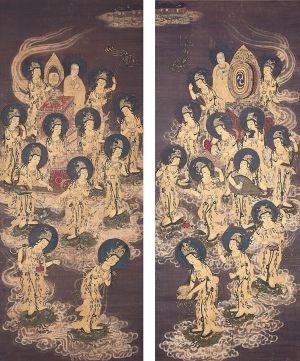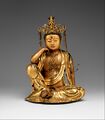بوذيساتڤا
| بوذيساتڤا (الكائن المستنير) Bodhisattva | |
|---|---|
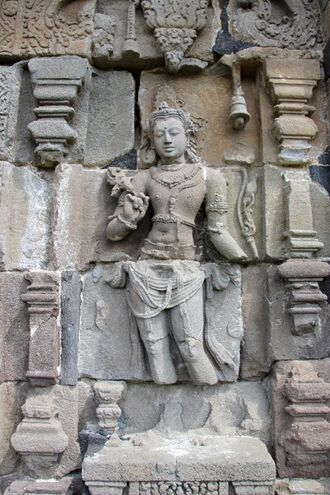 | |
| بالسنسكريتية | बोधिसत्त्व (Bodhisattva) |
| پالي | बोधिसत्त (Bodhisatta) |
| بالبورمية | ဗောဓိသတ် (bɔ́dḭθaʔ) |
| بالصينية | 菩薩/菩提薩埵, (pinyin: púsà/pútísàduǒ), (Jyutping: pou4 saat3/pou4 tai4 saat3 do3), (ويد–جايلز: p'u2-sa4) |
| باليابانية | 菩薩 (روماجي: bosatsu) |
| بالخمير | ពោធិសត្វ (Pothisat) |
| بالكورية | 보살, 菩薩 (RR: بوسال) |
| بالتايلندية | โพธิสัตว์ (phothisat) |
| بالتبتية | བྱང་ཆུབ་སེམས་དཔའ་ (byang chub sems dpa') |
| بالڤيتنامية | Bồ Tát/Bồ Xát 菩薩 |
| معلومات | |
| يـُبجـِّله | ثرڤادا، مهايانا، ڤاجرايانا |
في البوذية، بوذيساتڤا (بالسنسكريتية: बोधिसत्त्व بوذيساتڤا؛ پالي: बोधिसत्त بوذيساتـّا؛ إنگليزية: bodhisattva) هو كائن (ساتڤا) مستنير (بوذي). وتقليدياً، فإن البوذيساتڤا هو أي شخص، مدفوع بتعاطف كبير، ويُبدي بوذيچيتـّا، التي هي رغبة لحظية في بلوغ البوذوية لخير كل الكائنات الواعية.[1] وفي البوذية التبتية، فإن البوذيساتڤا هو أحد الحالات السامية الأربع التي يمكن للبشر تحقيقها في الحياة (الحالات الثلاث الأخر هن: أرهات، بوذا، وپراتيكابوذايانا).[2]
البوذيساتڤا هي موضوع ذو شعبية في الفن البوذي. فاستخدام التعبير بوذيساتڤا قد تطور على مر الزمن. ففي البوذية الهندية المبكرة، على سبيل المثال، فقد كان التعبير بوذيساتڤا يُستخدم أساساً للإشارة بالتحديد إلى بوذا في حيواته السابقة.[3][4] فالجاتكات، التي هي قصص حيواته، تصور "محاولات البوذيساتڤا المتعددة لاعتناق مآثر مثل التضحية بالذات والخلق الحميد.[4]
في بوذية ثراڤادا
التعبير "بوذيساتـّا" (بلغة پالي، وبالإنگليزية: bodhisatta) استخدمه البوذا في شريعة پالي ليشير إلى نفسه في كل من حيواته السابقة ولشبابه في حياته الحالية، قبل الاستنارة، في الفترة التي كان يعمل على بلوغ تحرره. فأثناء حواراته، حين كان يسرد تجاربه كطامح شاب، فإنه يستخدم بشكل منتظم التعبير "حين كنت بوذيساتـّا غير مستنير..." ولذلك فالمصطلح يشير لكائن "في طريق للاستنارة"، أي بكلمات أخرى، شخص هدفه أن يصبح مستنيراً بالكامل. وفي شريعة پالي، يوصف البوذيساتـّا كشخص مازال عرضة للميلاد والمرض والموت والحزن والنجاسة والوهم. وبعض حيوات البوذا السابقة كبوذيساتڤا مذكورة في الجاتكات.
وفي أدبيات ثراڤادا اللاحقة، اُستُخدم التعبير "بوذيساتـّا" بكثرة لوصف أن شخصاً ما هو طريقه للتحرر.[5] The later tradition of commentary also recognizes the existence of two additional types من البوذيساتـّات: paccekabodhisatta الذي سيبلغ Paccekabuddhahood، و savakabodhisatta الذي يبلغ الاستنارة كحواريّ لأي بوذا. وحسب معلـِّم الثراڤادا، بيخـّو بوذي، فإن طريق البوذيساتڤا لم يُعلـِّمه البوذا.[6]
ملوك سري لانكا كثيرا ما وُصِفوا بأنهم بوذيساتڤا، بدءاً على الأقل منذ سيريسانغابوذي (ح. 247-249)، الذي اشتهر بالمرحمة، والذي أخذ على نفسه عهوداً برفاهية شعبه، وكان يُعتبر مهاساتـّا (بالسنسكريتية: مهاساتڤا)، وهو اللقب الذي كان مقصوراً على بوذيساتڤات المهايانا.[7] Many other kings of Sri Lanka from the 3rd century until the 15th century were also described as bodhisattvas, and their royal duties were sometimes clearly associated with the practice of the Ten Pāramitās.[8]
وقد ذكر البيخـّو والدارس الثراڤادي والپولا راهولا (سري راهولا مها ثـِرا) أن البوذيساتڤا كمثل أعلى جرت العادة أن يُنظر إليه كمرتبة أعلى من شراڤكا ليس فقط في الهايانا، ولكن أيضاً في بوذية ثـِراڤادا. كما ينقل نقشاً من ملك سري لانكا بالقرن العاشر، ماهندا الرابع (956-972 م) الذي أمر بنقش تلك الكلمات "لا أحد إلا البوذيساتڤات سيصبح ملكاً على لانكا الثرية"، بين أمثلة أخرى.[9][10]
There is a wide-spread belief, particularly in the West, that the ideal of the Theravada, which they conveniently identify with Hinayana, is to become an Arahant while that of the Mahayana is to become a Bodhisattva and finally to attain the state of a Buddha. It must be categorically stated that this is incorrect. This idea was spread by some early Orientalists at a time when Buddhist studies were beginning in the West, and the others who followed them accepted it without taking the trouble to go into the problem by examining the texts and living traditions in Buddhist countries. But the fact is that both the Theravada and the Mahayana unanimously accept the Bodhisattva ideal as the highest.
— Walpola Rahula, Bodhisattva Ideal in Buddhism
ويكتب پول وليام أن بعض أساتذة التأمل المعاصرين في الثراڤادا في تايلند يُعتبرون شعبياً بوذيساتڤات.[11]
Cholvijarn observes that prominent figures associated with the Self perspective in Thailand have often been famous outside scholarly circles as well, among the wider populace, as Buddhist meditation masters and sources of miracles and sacred amulets. Like perhaps some of the early Mahāyāna forest hermit monks, or the later Buddhist Tantrics, they have become people of power through their meditative achievements. They are widely revered, worshipped, and held to be arhats or (note!) bodhisattvas.
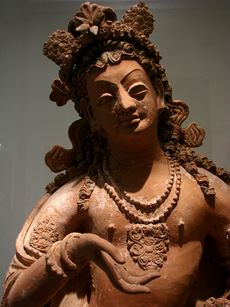 نحت طيني لبوذيساتڤا. أفغانستان، القرن السابع |
في بوذية المهايانا
بوذيساتڤا هو المثل الأعلى
تقوم بوذية مهايانا أساساً على طريق البوذيساتڤا. According to Jan Nattier, the term Mahāyāna ("Great Vehicle") was originally even an honorary synonym for Bodhisattvayāna, or the "Bodhisattva Vehicle."[12] The Aṣṭasāhasrikā Prajñāpāramitā Sūtra contains a simple and brief definition for the term bodhisattva, which is also the earliest known Mahāyāna definition.[13][14] This definition is given as the following.[15]
Because he has enlightenment as his aim, a bodhisattva-mahāsattva is so called.
Mahāyāna Buddhism encourages everyone to become bodhisattvas and to take the bodhisattva vows. With these vows, one makes the promise to work for the complete enlightenment of all sentient beings by practicing the six perfections.[16] Indelibly entwined with the bodhisattva vow is merit transference (pariṇāmanā).
الأراضي العشر
According to many traditions within Mahāyāna Buddhism, on the way to becoming a Buddha, a bodhisattva proceeds through ten, or sometimes fourteen, grounds or bhūmis. Below is the list of the ten bhūmis and their descriptions according to the Avataṃsaka Sūtra and The Jewel Ornament of Liberation, a treatise by Gampopa, an influential teacher of the Tibetan Kagyu school. (Other schools give slightly variant descriptions.)
Before a bodhisattva arrives at the first ground, he or she first must travel the first two of the five paths:
- the path of accumulation
- the path of preparation
The ten grounds of the bodhisattva then can be grouped into the next three paths
- bhūmi 1 the path of insight
- bhūmis 2-7 the path of meditation
- bhūmis 8-10 the path of no more learning
The chapter of ten grounds in the Avataṃsaka Sūtra refers to 52 stages. The 10 grounds are:
- Great Joy: It is said that being close to enlightenment and seeing the benefit for all sentient beings, one achieves great joy, hence the name. In this bhūmi the bodhisattvas practice all perfections (pāramitās), but especially emphasizing generosity (dāna).
- Stainless: In accomplishing the second bhūmi, the bodhisattva is free from the stains of immorality, therefore, this bhūmi is named "stainless". The emphasized perfection is moral discipline (śīla).
- Luminous: The third bhūmi is named "luminous", because, for a bodhisattva who accomplishes this bhūmi, the light of Dharma is said to radiate for others from the bodhisattva. The emphasized perfection is patience (kṣānti).
- Radiant: This bhūmi is called "radiant", because it is said to be like a radiating light that fully burns that which opposes enlightenment. The emphasized perfection is vigor (vīrya).
- Very difficult to train: Bodhisattvas who attain this bhūmi strive to help sentient beings attain maturity, and do not become emotionally involved when such beings respond negatively, both of which are difficult to do. The emphasized perfection is meditative concentration (dhyāna).
- Obviously Transcendent: By depending on the perfection of wisdom, [the bodhisattva] does not abide in either saṃsāra or nirvāṇa, so this state is "obviously transcendent". The emphasized perfection is wisdom (prajñā).
- Gone afar: Particular emphasis is on the perfection of skillful means (upāya), to help others.
- Immovable: The emphasized virtue is aspiration. This, the "immovable" bhūmi, is the bhūmi at which one becomes able to choose his place of rebirth.
- Good Discriminating Wisdom: The emphasized virtue is power.
- Cloud of Dharma: The emphasized virtue is the practice of primordial wisdom.
After the ten bhūmis, according to Mahāyāna Buddhism, one attains complete enlightenment and becomes a Buddha.
With the 52 stages, the Śūraṅgama Sūtra recognizes 57 stages. With the 10 grounds, various Vajrayāna schools recognize 3–10 additional grounds, mostly 6 more grounds with variant descriptions.[17][18]
A bodhisattva above the 7th ground is called a mahāsattva. Some bodhisattvas such as Samantabhadra are also said to have already attained buddhahood.[19]
أصل الاسم
The etymology of the Indic terms bodhisattva and bodhisatta is not fully understood. The term bodhi is uncontroversial and means "awakening" or "enlightenment" (from the root budh-).[20][21] The second part of the compound has many possible meanings or derivations, including:[22]
- Sattva and satta commonly means "living being", "sentient being" or "person" and many modern scholars adopt an interpretation based on this etymology. Examples include: "a sentient or reasonable being, possessing bodhi" (H. Kern), "a bodhi-being, i.e. a being destined to attain fullest Enlightenment" (T. W. Rhys Davids and W. Stede), "A being seeking for bodhi" (M. Anesaki), "Erleuchtungswesen" (Enlightenment Being) (M. Winternitz), "Weisheitswesen" ("Wisdom Being") (M. Walleser).[23] This etymology is also supported by the Mahayana Samādhirāja Sūtra, which, however, explains the meaning of the term bodhisattva as "one who admonishes or exhorts all beings."[24]
- According to Har Dayal, the term bodhi-satta may correspond with the Sanskrit bodhi-sakta which means "one who is devoted to bodhi" or "attached to bodhi". Later, the term may have been wrongly sanskritized to bodhi-satva.[25] Hayal notes that the Sanskrit term sakta (from sañj) means "clung, stuck or attached to, joined or connected with, addicted or devoted to, fond of, intent on".[25] This etymology for satta is supported by some passages in the Early Buddhist Texts (such as at SN 23.2, parallel at SĀ 122). The etymology is also supported by the Pāli commentaries, Jain sources and other modern scholars like Tillman Vetter and Neumann.[26] Another related possibility pointed out by K.R. Norman and others is that satta carries the meaning of śakta, and so bodhisatta means "capable of enlightenment."[27]
- The Sanskrit term sattva may mean "strength, energy, vigour, power, courage" and therefore, bodhisattva could also mean "one whose energy and power is directed towards bodhi".[28] This reading of sattva is found in Ksemendra's AvadanakalpaIata. Har Dayal supports this reading, noting that the term sattva is "almost certainly related to the Vedic word satvan, which means 'a strong or valiant man, hero, warrior'" and thus, the term bodhisatta should be interpreted as "heroic being, spiritual warrior."[29]
- Sattva may also mean spirit, mind, sense, consciousness, or geist. Various Indian commentators like Prajñakaramati interpret the term as a synonym for citta (mind, thought) or vyavasāya (decision, determination).[24] Thus, the term bodhisattva could also mean: "one whose mind, intentions, thoughts or wishes are fixed on bodhi".[24] In this sense, this meaning of sattva is similar to the meaning it has in the Yoga-sutras, where it means mind.[24]
- Tibetan lexicographers translate bodhisattva as byang chub (bodhi) sems dpa (sattva). In this compound, sems means mind, while dpa means "hero, strong man" (Skt. vīra). Thus, this translation combines two possible etymologies of sattva explained above: as "mind" and as "courageous, hero".[30]
- Chinese Buddhists generally use the term pusa (菩薩), a phonetic transcription of the Sanskrit term. However, early Chinese translators sometimes used a meaning translation of the term bodhisattva, which they rendered as mingshi (明士), which means "a person who understands", reading sattva as "man" or "person" (shi, 士).[31][32]
- In Sanskrit, sattva can mean "essence, nature, true essence", and the Pali satta can mean "substance". Some modern scholars interpret bodhisattva in this light, such as Monier-Williams, who translates the term as "one who has bodhi or perfect wisdom as his essence."[23]
معرض
Standing bodhisattva. Gandhāra, 2nd–3rd century
The golden Srivijayan Bodhisattva Avalokiteśvara, Muarabulian, Jambi, Indonesia c. 11th century
Thousand-armed Bodhisattva, Sanjūsangen-dō, Japan. 13th century
A rock carving of Avalokiteshvara, Weligama, Sri Lanka
Silver Manjushri, Sailendra, early 9th century Central Java, National Museum
Jizō Bosatsu, Japan
Samantabhadra, Yulin Cave 3, Western Xia
انظر أيضاً
- بوذيچارياڤاتارا (دليل إلى طريق البوذيساتڤا في الحياة)
- عهود البوذيساتڤا
- عطلات بوذية
- كارونا (المرحمة بالسنسكريتية)
- قائمة البوذيساتڤات
- النباتية في البوذية
الهامش
- ^ The Bodhisattva Vow: A Practical Guide to Helping Others, page 1, Tharpa Publications (2nd. ed., 1995) ISBN 978-0-948006-50-0
- ^ P. 313 Brilliant Moon: The Autobiography of Dilgo Khyentse by Dilgo Khyentse
- ^ Coomaraswamy, Ananda (1975). Buddha and the Gospel of Buddhism. Boston: University Books. p. 225. LCCN 64056434.
...the term Bodhisatta, or Wisdom-being, first used of Gautama between the Going-forth and the attainment of Nibbāna, came to mean a Buddha-designate....
- ^ أ ب http://www.britannica.com/EBchecked/topic/70982/bodhisattva
- ^ 南傳菩薩道(上)
- ^ [1]
- ^ Holt, John. Buddha in the Crown : Avalokitesvara in the Buddhist Traditions of Sri Lanka. 1991. p. 59
- ^ Holt, John. Buddha in the Crown : Avalokitesvara in the Buddhist Traditions of Sri Lanka. 1991. pp. 59-60
- ^ "Bodhisattva Ideal in Buddhism". Access to Insight. Retrieved 2010-04-18.
- ^ Holt, John. Buddha in the Crown : Avalokitesvara in the Buddhist Traditions of Sri Lanka. 1991. p. 60
- ^ Paul Williams, Mahāyāna Buddhism: The Doctrinal Foundations. Taylor & Francis, 1989, page 328.
- ^ Nattier, Jan (2003), A few good men: the Bodhisattva path according to the Inquiry of Ugra: p. 174
- ^ Mall, Linnart. Studies in the Astasahasrika Prajnaparamita and Other Essays. Motilal Banarsidass. 2005. pp. 53-54.
- ^ Hirakawa, Akira. A history of Indian Buddhism: from Śākyamuni to Early Mahāyāna. Motilal Banarsidass. 2007. p. 297.
- ^ Conze, Edward. The Perfection of Wisdom in Eight Thousand Lines and its Verse Summary. Grey Fox Press. 2001. p. 89.
- ^ The Bodhisattva Vow: A Practical Guide to Helping Others, pages 4-12, Tharpa Publications (2nd. ed., 1995) ISBN 978-0-948006-50-0
- ^ 大圆满心性休息颂[dead link]
- ^ 吉祥鄔金密嚴寺: 八地在般若乘和金剛乘的分別
- ^ 459 因地菩薩和果地菩薩
- ^ Williams, Paul (2008). Mahayana Buddhism: The Doctrinal Foundations, pp. 286-287. Routledge.
- ^ Dayal, Har (1970). The Bodhisattva Doctrine in Buddhist Sanskrit Literature, p. 4. Motilal Banarsidass Publ.
- ^ Dayal, Har (1970). The Bodhisattva Doctrine in Buddhist Sanskrit Literature, pp. 4-7. Motilal Banarsidass Publ.
- ^ أ ب Dayal, Har (1970). The Bodhisattva Doctrine in Buddhist Sanskrit Literature, pp. 4-5. Motilal Banarsidass Publ.
- ^ أ ب ت ث Dayal, Har (1970). The Bodhisattva Doctrine in Buddhist Sanskrit Literature, p. 6. Motilal Banarsidass Publ.
- ^ أ ب Dayal, Har (1970). The Bodhisattva Doctrine in Buddhist Sanskrit Literature, p. 7. Motilal Banarsidass Publ.
- ^ Bhikkhu Analayo; Zimmermann, Michael (2010). The Genesis of the Bodhisattva Ideal, p. 19, Hamburg Buddhist Studies (Hamburg University Press).
- ^ Norman K.R. (1990/1993) "Pāli Philology and the Study of Buddhism", in Collected Papers, Volume IV, K.R. Norman (ed.), Oxford: The Pali Text Society, 80‒91.
- ^ Dayal, Har (1970). The Bodhisattva Doctrine in Buddhist Sanskrit Literature, pp. 7-8. Motilal Banarsidass Publ.
- ^ Dayal, Har (1970). The Bodhisattva Doctrine in Buddhist Sanskrit Literature, p. 9. Motilal Banarsidass Publ.
- ^ Dayal, Har (1970). The Bodhisattva Doctrine in Buddhist Sanskrit Literature, p. 8. Motilal Banarsidass Publ.
- ^ Zürcher, Erik (2013). Buddhism in China: Collected Papers of Erik Zürcher, p. 431. BRILL.
- ^ Pu, Chengzhong. Notes on the Chengju guangming jing, 'Sūtra of Achieving the Bright Light Concentration'. Buddhist Studies Review 25(1) 2008, 27–53. ISSN (online): 1747-9681.
المراجع
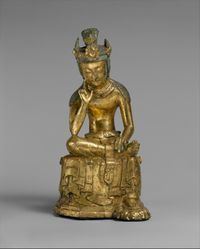
- Analayo, The Genesis of the Bodhisattva Ideal, Hamburg Buddhist Studies 1, Hamburg University Press 2010
- Gampopa; The Jewel Ornament of Liberation; Snow Lion Publications; ISBN 1-55939-092-1
- White, Kenneth R.; The Role of Bodhicitta in Buddhist Enlightenment: Including a Translation into English of Bodhicitta-sastra, Benkemmitsu-nikyoron, and Sammaya-kaijo; The Edwin Mellen Press, 2005; ISBN 0-7734-5985-5
- Lampert, K.; Traditions of Compassion: From Religious Duty to Social Activism. Palgrave-Macmillan; ISBN 1-4039-8527-8
- Gyatso, Geshe Kelsang Gyatso, The Bodhisattva Vow: A Practical Guide to Helping Others, Tharpa Publications (2nd. ed., 1995) ISBN 978-0-948006-50-0
- Shantideva: Guide to the Bodhisattva's Way of Life: How to Enjoy a Life of Great Meaning and Altruism, a translation of Shantideva's Bodhisattvacharyavatara with Neil Elliott, Tharpa Publications (2002) ISBN 978-0-948006-88-3
- The Making of a Savior Bodhisattva: Dizang in Medieval China, by Zhiru (Kuroda Institute Studies in East Asian Buddhism series no. 21), University of Hawaii Press, 2007; ISBN 978-0-8248-3045-8 في كتب گوگل
وصلات خارجية
- Bodhisattva, probably Avalokiteshvara (Guanyin), Northern Qi dynasty, c. 550--60, video, Smarthistory.
- The Thirty-Seven Practices of Bodhisattvas, all-in-one page with memory aids & collection of different versions.
- Audio recitation of 'The 37 Practices of Bodhisattvas' in MP3 format (Paul & Lee voices).
- What A Bodhisattva Does: Thirty-Seven Practices by Ngulchu Thogme with slide show format.
- Access to Insight Library: Bodhi's Wheel409
- Online exhibition analyzing a Korean Bodhisattva
- Buddhanet.net Ksitigarbha Bodhisattva
- Articles with dead external links from February 2014
- Short description is different from Wikidata
- Portal-inline template with redlinked portals
- Pages with empty portal template
- Articles containing سنسكريتية-language text
- Articles containing پالي-language text
- Articles containing إنگليزية-language text
- Pages using Lang-xx templates
- بوذيساتڤات
- مفاهيم فلسفية بوذية
- ألقاب بوذية
- قوائم الآلهة

